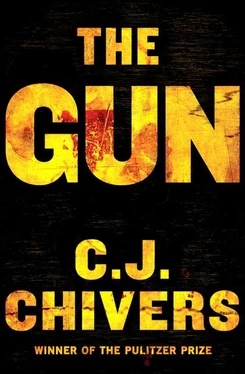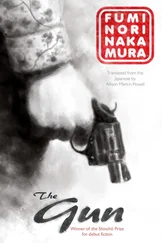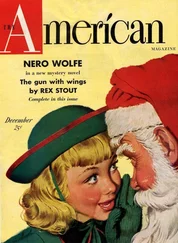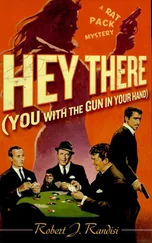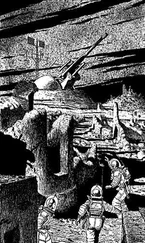Then came the shock. On April 27, the battalion was preparing for combat against dug-in NVA units on Hills 861 and 881 near Khe Sanh. It spent much of the day watching artillery and air strikes pounding suspected NVA positions on the high ground. On April 29, the company moved toward Hill 881 North, and that night, after recovering the remains of a missing Marine, it spent the night in the bush on the approach to the southeast of Hill 881 North. On April 30, the company moved out on foot again, jumping into an attack at first light with Second and Third platoons abreast of each other and moving forward in a battle formation known as “on line.” In Third Platoon, as Second Lieutenant Thomas R. Givvin, the platoon commander, walked uphill he found at least five M-16s with cleaning rods forced down their barrels resting on the ground. 60These were the discards of Marines who had fought on the hill several days before. Hotel Company moved through tall elephant grass and was ambushed at a distance of about fifty meters by the North Vietnamese Army.
The ambush turned swiftly into a brutal close-quarters fight. Rifle by rifle, several of the Marines’ new M-16s jammed. 61The malfunctions had consistency, and most common was a failure to extract. To resume firing the troops needed to thread together several sections of narrow metal pipe, the military’s standard-issue rifle-cleaning rods, and plunge the rod down the barrel from the muzzle to try to knock the spent shell case free. It was a movement akin to what Revolutionary War soldiers had had to do to reload muskets nearly two hundred years before. Only then could a grunt with a stopped rifle force out the empty cartridge case and load for another try. “Punching a bore,” as this clearing action was called, was a tedious exercise on a rifle range. It was especially difficult to do when the spent cartridge case was torn. In battle it left riflemen unable to defend themselves and the men on their left and right, and was cause for fury and frustration. After conferring by radio with the battalion commander, Captain Raymond C. Madonna, Hotel Company’s commander in spring 1967, ordered Hotel Company to fall back so they could call in air strikes and artillery fire. The two sides had been too close for the Marines to mass supporting fire without endangering themselves. The company relied on its own 60-millimeter mortars and 3.5-millimeter rockets for fire support. Hotel Company suffered eight dead Marines and one dead corpsman that day. Forty-three others were wounded.
On May 3, the remnants of Hotel Company and part of Foxtrot Company were ordered to help Echo Company, which had been pinned down in front of a network of NVA bunkers on Hill 881 North. Foxtrot Company would approach from the southeast. Hotel Company would envelop around Echo Company and attack from the north; the plan was to get behind the NVA bunker line and strike the enemy’s rear. Captain Madonna and his Marines stepped off at dawn and began a long flanking movement on foot down a ravine and then through the triple-canopy jungle; they moved for as long as nine hours to get behind the NVA.
Hotel Company had only one platoon—First Platoon—that was still at fighting strength. As the sweat-soaked Marines at last moved near the enemy bunkers, and were preparing to rush, the captain gave an order over the radio to his platoon commander, Second Lieutenant Ord Elliott: Fix bayonets. He was effectively telling men to prepare to fight to the death, hand to hand. The order was superfluous. Lieutenant Elliot had come to the same decision himself. He had already told the men to ready their knives. With bayonets affixed, the officers thought, the Marines whose M-16s failed might slash or stab their way through the bunkers. 62It was 1967, the age of the nuclear-powered aircraft carrier, the B-52 Stratofortress, and the submarine-launched Polaris ballistic missile. A Marine Corps platoon and company commander were preparing their men for an attack in which they would wield their rifles like lances, swords, and spears. And that was Captain Madonna’s assessment of Colt’s assault rifle, circa 1967. “It was a pretty good bayonet holder,” he said. “I knew those weapons were failing. I didn’t know what the rate was, but I knew I couldn’t rely on them anymore.”
First Platoon had entered a gully where the elephant grass was tall and the air was silent; not even a bird could be heard. The fighting erupted as the platoon moved through the low ground, with North Vietnamese soldiers firing through dense vegetation, concealed in bunkers and spider holes. Under fire, the platoon’s First Squad moved against one of the bunkers, with the leader of First Fire Team, Corporal Cornelio Ybarra Jr., crawling forward with a hand grenade. He tossed the grenade inside. There was a tremendous blast. Corporal Ybarra, known to his friends as Y, stood and headed for the next bunker. A close-quarters battle raged along the line, but each man was limited in what he could see by the heavy bush, and by the thick bursts of bullets cracking by. Luckily, the fire team was not spread too widely. One of its members, Private First Class Roy W. DeMille, was struggling with a jammed M-16. The team’s grenadier gave him a .45-caliber pistol, so he would have a weapon that might work. DeMille was still trying to revive his rifle when he saw a bloody NVA soldier stagger out of the shattered bunker with a Kalashnikov. DeMille was helpless, holding a jammed M-16. He was about, it seemed, to die.
“Y!” DeMille yelled to his team leader. “A gook!”
Corporal Ybarra turned and reacted instinctively. His magazine had seventeen rounds. His M-16 was set on automatic. He fired at close-range until the clip was empty, killing the dazed Vietnamese man.
Fortunately for Private First Class DeMille, whose M-16 had failed, Corporal Ybarra’s had not. 63
The Hill Fights claimed more lives than any Marine action yet in the war. More than 150 Marines were killed. Several hundred more were wounded. Many elements of Marine firepower had worked together as two battalions had claimed the high ground. Attack aircraft, artillery, and mortars had pounded the North Vietnamese positions. The most basic piece of equipment had failed. By May 5, the jamming had been widespread enough that sadly surreal scenes unfolded at one helicopter landing zone on Hill 881 North, where wounded Marines, who had been hit in a mortar bombardment, were waiting to be evacuated. Marines who had not been wounded wandered among the casualties, asking their bloodied colleagues if their rifles had worked. When they found a wounded Marine whose rifle had performed well, they asked to trade and exchanged a faulty M-16 for the M-16 that had reliably fired. Other Marines had also found that three pins near the trigger assembly had a tendency to work loose and slip out, rendering the rifles useless. 64Over several days, the Marines’ initial satisfaction with their M-16s had turned to astonishment, then disgust. Emotions were further inflamed by a sense among troops that the Pentagon had failed to provide them with enough cleaning rods, as the army technical team had found when they visited Vietnam six months before. 65One survivor vented to the Asbury Park Evening Press:
Believe it or not, you know what killed most of us? Our own rifle. Before we left Okinawa, we were all issued the new rifle, the M-16. Practically everyone of our dead was found with his rifle tore down next to him where he had been trying to fix it. 66
Back in Washington, the Marine Corps pushed back. It denied that the problems were extensive and insisted that the M-16 was reliable and that statements from Marines who said otherwise were exaggerated. There were, as is often the case, grains of truth in the official statements, just as there were errors and exaggerations in some of the troops’ accounts. In the Hill Fights rifles failed; by most accounts, many rifles. But the claim that “practically everyone of our dead was found with his rifle tore down next to him” was overstatement, at least battalionwide. By seizing on such statements and becoming argumentative, the officers in Washington missed the substantial truth: M-16s were failing at an alarming rate, the failures put lives at risk, and the grunts had lost faith in their rifles and in some cases in their chain of command. The officers had entered an argument they could not win. This was in part because by this time, the congressional subcommittee was gathering its own information, which pointed to widespread malfunctions and a pattern of false official statements by generals who were trying to convince inquirers that all was well. In May, Ralph Marshall, a lawyer working for the subcommittee, visited the Great Lakes Naval Hospital in Illinois to interview wounded GIs. Marshall found twenty-two Marines who had fought with M-16s in Vietnam. Eleven had experienced jamming. Some of their accounts were jarring. “In a squad of 14 all rifles jammed—in another patrol 9 jammed,” he wrote. “Several of the marines had requested the return of their M-14 rifles in place of the newly issued M-16 because they had lost confidence in the M-16.” 67
Читать дальше
